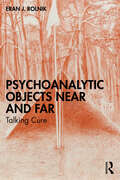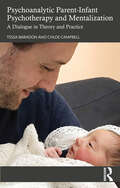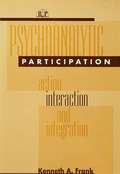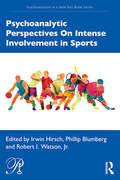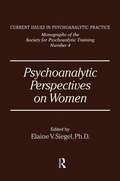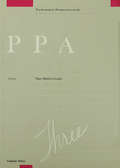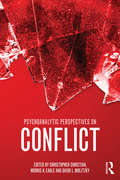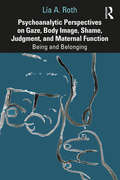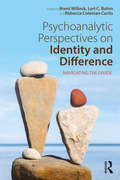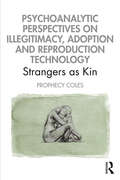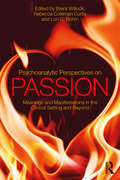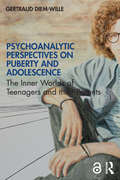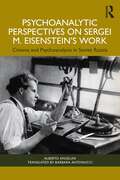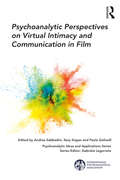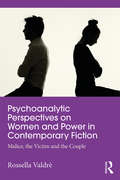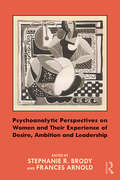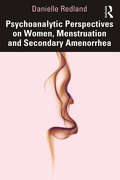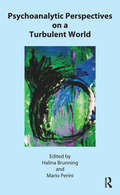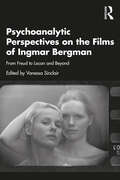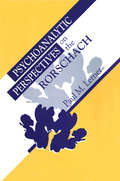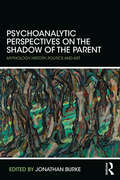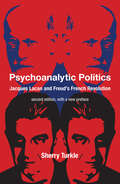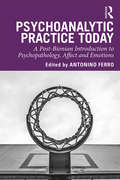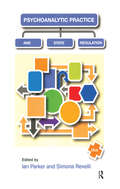- Table View
- List View
Psychoanalytic Objects Near and Far: Talking Cure
by Eran J. RolnikTouching upon the most sensitive nuances of the analytic encounter, Psychoanalytic Objects Near and Far combines a far-reaching theoretical manifesto with an intimate clinical journal to express curiosity, skepticism and love towards the psychoanalytic clinic, theory and history. Basic concepts and controversies that often become a conceptual ivory tower receive here a new and fresh vitality from the perspective of an experienced clinician, scholar and teacher, all while crossing the boundary of theoretical fantasy. While holding theory as central to the clinical act, Rolnik does not see it as a self-sufficient philosophy, detached from the free spirit of psychoanalysis as a practice and ethics. Rolnik has no need for iconoclasm. He is committed to the curative speech – his patients’ and his own – as well as receptiveness to the unconscious space in the most Freudian sense of the word. This volume will be of great interest to analysts in practice and in training, and to any reader interested in the analytic process.
Psychoanalytic Parent-Infant Psychotherapy and Mentalization: A Dialogue in Theory and Practice
by Chloe Campbell Tessa BaradonThis book is an account of best practice in psychoanalytic parent-infant psychotherapy (PPIP) and mentalizing, bringing the two approaches in dialogue in relation to infancy. While being similar, PPIP and mentalizing emphasize different aspects of interpersonal processes and apply different ways of intervening. In this text, chapters detail how the models are put into practice, describing the different settings in which they are applied, and the research that has been undertaken to shape them. Exploring the ideas and practice of both approaches, including how they may complement each other and where differing stances may be adopted in relation to clinical material and therapy, this volume enriches the range of ways of working available to the clinician. Psychoanalytic Parent-Infant Psychotherapy and Mentalization provides an overview of the practices of PPIP and mentalization for professionals, but also for anyone interested in understanding the model of psychotherapy and the ideas behind it.
Psychoanalytic Participation: Action, Interaction, and Integration (Relational Perspectives Book Series #16)
by Kenneth A FrankIn Psychoanalytic Participation: Action, Interaction, and Integration, Kenneth Frank argues that the gulf between analysis and what he terms "action-oriented" or cognitive-behavioral techniques is anachronistic and has unnecessarily limited the repertoire of analytically oriented clinicians. In point of fact, action-oriented and even cognitive-behavioral techniques may be employed in ways that are consistent with the analytic goal of promoting profound personality change, and so may be profitably incorporated into analytic treatments. Anchoring his discussion in a contemporary two-person model of psychoanalysis, Frank clarifies and extends the shift toward analyst participation that has developed within recent relational theorizing. On the basis of this orientation, which calls attention to the therapeutic importance of the real qualities of the analyst and of the analytic relationship, Frank sets forth a pragmatic analytic approach that balances traditional "process" elements with patients' problem-solving and outside progress in realizing life goals. By letting themselves be known by their patients and by participating intensively and actively in their treatment, analysts as analysts can help patients shape new and adaptive behaviors in their daily lives. It is the participatory possibilities growing out of a contemporary relational perspective that provide the ground for a rapprochement between psychoanalysis and cognitive-behavior therapy. To this end, Frank presents numerous examples of how action-oriented, cognitive-behavioral principles and techniques can be used to potentiate and accelerate the analytic process. At once scholarly and exploratory, pragmatic and visionary, Psychoanalytic Participation helps shepherd psychoanalysis into the 21st century while making psychoanalytic wisdom - both traditional and contemporary - available to the broad community of psychotherapists appreciative of the usefulness of cognitive-behavioral treatment strategies.
Psychoanalytic Perspectives On Intense Involvement in Sports (Psychoanalysis in a New Key Book Series)
by Irwin HirschThis book is a unique volume that brings a variety of psychoanalytic perspectives to the study of sport. It highlights the importance of sports for different individuals and how the function and use of sports can be brought into the consulting room. Passionate interest in actively engaging in sports is a universal phenomenon. It is striking that this aspect of human life, prior to this volume, has received little attention in the literature of psychoanalysis. This edited volume is comprised largely of psychoanalysts who are themselves avidly involved with sports. It is suggested that intense involvement in sports prioritizes commitment and active engagement over passivity and that such involvement provides an emotionally tinged distraction from the various misfortunes of life. Indeed, the ups and downs in mood related to athletic victory or defeat often supplant, temporarily, matters in life that may be more personally urgent. Engaging in sports or rooting for teams provides a feeling of community and a sense of identification with like-minded others, even among those who are part of other communities and have sufficient communal identifications. This book offers a better psychoanalytic understanding of sports to help us discover more about ourselves, our patients and our culture, and will be of great interest to psychotherapists and psychoanalysts, or anyone with an interest in sport and its link to psychoanalysis and mental health.
Psychoanalytic Perspectives On Women
by Elanie V. SiegelFirst published in 1992. Routledge is an imprint of Taylor & Francis, an informa company.
Psychoanalytic Perspectives on Art, V. 3
by Mary Mathews GedoThis new hardcover annual offers a unique scholarly format, an interdisciplinary dialogue that, it is hoped, will foster the development of a sound, useful methodology for applying psychoanalytic insight to art and artists. The series provides a medium for those who study art, those who interpret it, and occasionally those who create it, formally to explore the meaning of an artistic work as the direct reflection of the inner world of its creator. Within each volume, individual topics are addressed by either an art historian or a psychoanalyst, with a response frequently tendered by an expert from the other field. Reviews of important books of cross-disciplinary interest are treated in a similar manner, and include rebuttals by the authors themselves. It is precisely this exchange of ideas among scholars with difference perspectives on the meaning of a work of art that sets PPA apart from the standard art history publication. Its depth of scholarship, coupled with its innovative format, make it a fascinating addition to the burgeoning field of psychoanalytic studies of art history.
Psychoanalytic Perspectives on Conflict (Psychological Issues)
by Morris N. Eagle Christopher Christian David L. WolitzkySince its inception, and throughout its history, psychoanalysis has been defined as a psychology of conflict. Freud’s tripartite structure of id, ego and superego, and then modern conflict theory, placed conflict at the center of mental life and its understanding at the heart of therapeutic action. As psychoanalysis has developed into the various schools of thought, the understanding of the importance of mental conflict has broadened and changed. In Psychoanalytic Perspectives on Conflict, a highly distinguished group of authors outline the main contemporary theoretical understandings of the role of conflict in psychoanalysis, and what this can teach us for everyday psychoanalytic practice. The book fills a gap in psychoanalytic thinking as to the essence of conflict and therapeutic action, at a time when many theorists are re-conceptualizing conflict in relation to aspects of mental life as an essential component across theories. Psychoanalytic Perspectives on Conflict will be of interest to psychologists, psychoanalysts, social workers, and other students and professionals involved in the study and practice of psychoanalysis, psychotherapy, cognitive science and neuroscience.
Psychoanalytic Perspectives on Gaze, Body Image, Shame, Judgment and Maternal Function: Being and Belonging
by Lía A. RothHave you ever been praised or criticized about your body or any part of it? With this question, participants of a research study were invited to share their experiences of body judgment. As participants described, the body is a carrier of messages and the source of judgmental experiences. Psychoanalytic Perspectives on Gaze, Body Image, Shame, Judgment and Maternal Function: Being and Belonging offers an insightful and engaging psychoanalytical account of experiences of shame and fear of rejection, explained through clinical vignettes and research participants’ scripts. Exploring the findings from the individual and social standpoints, as well as the cultural and historical influences, Dr. Roth proposes that judgements are experienced as attacks, with the meaning attributed to the criticized body part, affecting the sense of self and forming a central point of the participants’ identity trauma. Furthermore, that as guilt requires reparative action, shame requires an act of sacrifice to align the individual to the ideal and to preserve the matrix of belonging, thus explaining the participants’ use of alienation as a defense. This book will be of great interest to psychoanalysts and psychotherapists, as well as scholars of culture and religion. Giving a brief introduction to psychoanalytic concepts, with a full glossary, it will also appeal to the non-psychoanalytic reader, interested in body image and how related perceptions and judgements can affect our own sense of Being and Belonging.
Psychoanalytic Perspectives on Identity and Difference: Navigating the Divide
by Brent Willock, Lori C. Bohm and Rebecca Coleman CurtisEvery day, clinicians encounter challenges to empathy and communication while struggling to assist patients with diverse life histories, character, sexuality, gender, psychopathology, cultural, religious, political, racial, and ethnic backgrounds. Most writing pertaining to ideas of similarity, discrepancy, and ‘the Other’ has highlighted differences. Psychoanalytic Perspectives on Identity and Difference: Navigating the Divide offers a different focus, emphasising points of contact, connection, and how divisions between people can be transcended. In-depth case material, astutely elucidated by diverse theoretical approaches, furnishes stimulating ideas and valuable suggestions for facilitating a meeting of minds and psychological growth in patients who might otherwise be difficult or impossible to engage. Exploring how psychoanalysts can navigate obstacles to understanding and communicating with suffering individuals, topics covered include: internal experience of likeness and difference in the patient; in the analyst; and how analysts can find echoes of themselves in patients. Psychoanalysts and psychotherapists will appreciate the importance and value of this wide-ranging, groundbreaking exploration of these insufficiently addressed dimensions of human experience.
Psychoanalytic Perspectives on Illegitimacy, Adoption and Reproduction Technology: Strangers as Kin
by Prophecy ColesIn this book, Prophecy Coles traces the existential history of the unwanted child with particular attention to the illegitimate child, linking myth, literature and clinical practice in the historical and legal context of adoption. From the time of the Reformation in the sixteenth century until the early twentieth century the lives of such children were short-lived. The Adoption Act of 1926 did much to change the moral climate and the fate of the illegitimate child. It provided the child with a legal family and a name. There follows some unexpected difficulties that emerged after World War Two. Adopted children did not necessarily thrive, and young mothers who had been forced to give up a child born out of wedlock revealed their suffering. The sealed records of the illegitimate child’s origins became an issue. Attachment theory and the development of neuroscience underpin the theoretical approach of this book. Today, the children who are available for adoption are older and may be distressed by several years in care. Fundamental to helping these adopted children and their families there needs to be a multi-disciplined therapeutic approach to try and mitigate the damage that has often been done to the early infant brain through trauma. This book brings to life some of the adoption issues through the study of personal memoirs. Each chapter considers adoption from a different angle: the adopted child, the birth mother, the birth father, foster parents and adopting parents. The final chapter discusses some of the problems around adoption that have arisen again with reproductive technology and surrogate mothering. This book will be of interest to all those who have been involved in or affected by adoption. It will be of special interest to those adopting parents who have not been properly prepared or supported in their magnificent work of taking on some of the most troubled children in our society.
Psychoanalytic Perspectives on Knowing and Being Known: In Theory and Clinical Practice
by Brent Willock Ionas Sapountzis Rebecca Coleman CurtisThe importance of knowing and being known is at the heart of the human experience and has always been the core of the psychoanalytic enterprise. Freud named his central Oedipal construct after Sophocles’ great play that dramatically encapsulated the desire, difficulty, and dangers involved in knowing and being known. Psychoanalysis’ founder developed a methodology to facilitate unconscious material becoming conscious, that is, making the unknown known to help us better understand ourselves and our relational lives, including psychic trauma, and multigenerational histories. This book will stimulate readers to contemplate knowing and being known from multiple perspectives. It bursts with thought-provoking ideas and intriguing cases illuminated by penetrating reflections from diverse theoretical perspectives. It will sensitize readers to this theme’s omnipresent, varied importance in the clinical setting and throughout life. Accomplished contributors discuss a wide variety of fascinating topics, illustrated by rich clinical material. Their contributions are grouped under these headings: Knowing through dreams; Knowing through appearances; Dreading and longing to be known; The analyst’s ways of knowing and communicating; Knowing in the contemporary sociocultural context; The known analyst; and No longer known. Readers will find each section deeply informative, stimulating thought, insights, and ideas for clinical practice. Psychoanalytic Explorations in Knowing and Being Known will appeal to psychoanalysts, psychotherapists, psychologists, psychiatrists, clinical social workers, counselors, students in these disciplines, and members of related scholarly communities.
Psychoanalytic Perspectives on Passion: Meanings and Manifestations in the Clinical Setting and Beyond
by Brent Willock Rebecca Coleman Curtis Lori C. BohmPassion! The word brims with and exudes power, movement, intensity, vitality, desire, and fulfillment. Its multifaceted meanings include eroticism, rage, sex, suffering, drive, commitment, dedication, and love. On the one hand, it embodies a quality to be embraced and lived fully, to make life meaningful and worthwhile. On the other, it is sometimes to be treated with suspicion, reined in, subjected to the dictates of reason. While it brightens existence and its departure makes life dull, many passions may prove unbearable. The manifold connotations of passion make it highly relevant to psychoanalysis, yet, so far, no book has explored the many facets of this pervasive theme. This book provides a comprehensive guide that will sensitize readers to the omnipresent importance of passionate emotion in the clinical setting, and throughout all areas and times of life. It bursts with thought-provoking ideas. Challenging cases are illuminated by penetrating reflections and novel applications and combinations of theoretical perspectives. Psychoanalytic Perspectives on Passion explores the many ways in which very strong emotions – passions – can be understood and worked with in clinical contexts. The contributions cover such key topics as psychosis and violence, emotions in childhood, sexuality, secure and insecure attachments, the role of passion in seeking meaning, passion and transition space, and transference and countertransference. This book will be of great help to all psychoanalysts and psychoanalytic psychotherapists struggling to assist patients (and perhaps themselves) in locating their passions, channeling and expressing them in meaningful ways, and overcoming obstacles to their fulfillment.
Psychoanalytic Perspectives on Puberty and Adolescence: The Inner Worlds of Teenagers and their Parents
by Gertraud Diem-WillePuberty is a time of tumultuous transition from childhood to adulthood activated by rapid physical changes, hormonal development and explosive activity of neurons. This book explores puberty through the parent-teenager relationship, as a "normal state of crisis", lasting several years and with the teenager oscillating between childlike tendencies and their desire to become an adult. The more parents succeed in recognizing and experiencing these new challenges as an integral, ineluctable emotional transformative process, the more they can allow their children to become independent. In addition, parents who can also see this crisis as a chance for their own further development will be ultimately enriched by this painful process. They can face up to their own aging as they take leave of youth with its myriad possibilities, accepting and working through a newfound rivalry with their sexually mature children, thus experiencing a process of maturity, which in turn can set an example for their children. This book is based on rich clinical observations from international settings, unique within the field, and there is an emphasis placed by the author on the role of the body in self-awareness, identity crises and gender construction. It will be of great interest to psychoanalysts, psychotherapists, parents and carers, as well as all those interacting with adolescents in self, family and society.
Psychoanalytic Perspectives on Sergei M. Eisenstein's Work: Cinema and Psychoanalysis in Soviet Russia
by Alberto AngeliniIn this insightful book, Alberto Angelini shows the influence of psychoanalysis and psychology on Sergei M. Eisenstein, one of the most celebrated Russian directors, and his cinematic output. Angelini situates Eisenstein’s life and oeuvre in the history and culture of twentieth-century Russia, drawing clear parallels between his networking with key figures such as Lev Vygotsky and Aleksandr Luria. He utilises the tools of psychology with the insight of psychoanalysis to illuminate the ways in which Eisenstein understood art as an anthropological enterprise while maintaining the same dialectical philosophy as the director in highlighting the many disciplines and figures that he drew inspiration from. Angelini also looks in depth at the influence psychoanalytic theories of regression had on Eisenstein’s approach to art, while examining the impact Stalinism had directly on both Eisenstein and psychoanalysis at large from the 1930s onwards. This book is an essential resource for psychoanalysts, students, and scholars of film studies, as well as those interested in the intersection between psychoanalytic theory, cinema, and the arts.
Psychoanalytic Perspectives on Virtual Intimacy and Communication in Film (The International Psychoanalytical Association Psychoanalytic Ideas and Applications Series)
by Andrea Sabbadini Ilany Kogan Paola GolinelliPsychoanalytic Perspectives on Virtual Intimacy and Communication in Film brings together a group of psychoanalysts to explore, through film, the new forms of communication, mainly the internet, that enter more and more frequently into the affective lives of people, their intimacy and even the analytic room. The contributors, all practising psychoanalysts, analyse the potential and surprising transformations that human relationships, including psychoanalysis, are undergoing. At present, it is difficult to value the future importance and predict the possible disquieting consequences of the use and abuse of the new technologies; we run the risk of finding ourselves unprepared to face this revolutionary transformation in human connections and affects. Will it be possible in a near future that human beings prefer to fall in love with a machine gifted with a persuasive voice instead of a psychoanalyst 'in person'? The contributors explore the idea that virtual intimacy could begin to replace real life, in sentimental and psychoanalytic relationships. Imagination and fantasy may be strengthened and may ultimately prevail over the body, excluding it entirely. Can the voice of the analyst, sometimes transmitted only by telephone or computer, produce a good enough analytic process as if it were in-person, or will it help to foster a process of idealisation and progressive alienation from real life and connections with other human beings? The film Her (2013), alongside others, offers a wonderful script for discussing this matter, because of the deep and thoughtful examination of love and relationships in the contemporary world that it provides. Psychoanalytic Perspectives on Virtual Intimacy and Communication in Film will be of great interest to all psychoanalysts and psychoanalytic psychotherapists interested in the ongoing impact of technology on human relationships.
Psychoanalytic Perspectives on Women and Power in Contemporary Fiction: Malice, the Victim and the Couple
by Rossella ValdrèPsychoanalytic Perspectives on Women and Power in Contemporary Fiction psychoanalytically examines contemporary fiction portraying the female in a reversal of the stereotyped victim role. The recent popularity of powerful female characters suggests that literature is ahead in its understanding the desires, fantasies and unconscious emotions of the public. This book explores a form of intimacy frequently observed in consulting rooms and in life in general: malicious intimacy. Specific to the conjugal bond, it is a type of intimacy connected to the relationship between the two halves of the couple that is extremely powerful and painful. Instead of clinical cases, Rossella Valdré examines four contemporary and widely successful novels, published contemporaneously, which capture perfectly this type of psychopathological universe. Valdré then maps out psychoanalytic hypotheses regarding the persistency of these malicious intimacies. Through analysis of these examples, Valdrè investigates the roots and hypotheses of a new scenario on victim-executioner roles played out in the intimacy of the couple. Exploring how and if the contemporary couple is undergoing profound changes, she provides an overview of the various deep-seated psychological mechanisms and unconscious dynamics that may be at work. The book explores the need to not be dependant upon a love object as an extreme defence against abandonment or self-collapse. Valdrè argues that such a configuration is very common, and that Idealization in contemporary life is one of the reasons behind the most of sufferance in modern couples, something which psychoanalysis can examine through art. Women, perhaps, after emancipation, are living overturned roles and paying a higher cost as a result. Psychoanalytic Perspectives on Women and Power in Contemporary Fiction will appeal to psychoanalysts and psychoanalytic psychotherapists, and be of interest to scholars and students of literature, gender studies, philosophy and sociology.
Psychoanalytic Perspectives on Women and Their Experience of Desire, Ambition and Leadership
by Stephanie Brody Frances ArnoldPsychoanalytic Perspectives on Women and Their Experience of Desire, Ambition and Leadership considers how these factors can be understood, nurtured, or thwarted and the subsequent impact on women’s identity, authority and satisfaction. Psychoanalysis has long struggled with its ideas about women, about who they are, how to work with them, and how to respect and encourage what women want. This book argues that psychoanalytic theory and practice must evolve to maintain its relevance in a volatile landscape. Each section of the book begins with a chapter that reviews contemporary ideas regarding women, as well as psychoanalytic history, gender bias, and societal norms and deficits. Three composite clinical stories allow our distinguished contributors to discuss the contexts within which individual experience can be affected, and the role that clinical work may have to mobilize and advance passion and vitality. In their discussions, the interplay of clinical psychoanalysis, sociopolitical context, and understanding of gender, combine to offer a unique perspective, built on decades of scholarship, personal experience, and clinical expertise. Psychoanalytic Perspectives on Women and Their Experience of Desire, Ambition and Leadership will serve as a reference for all psychoanalysts and psychoanalytic psychotherapists as well as gender studies scholars interested in the progress of psychoanalytic theory regarding women in the 21st century. Contributors to this book include: Rosemary Balsam, Brenda Bauer, Andrea Celenza, Diane Elise, Adrienne Harris, Dorothy Holmes, Nancy Kulish, Vivian Pendar, Dionne Powell, and Arlene Richards.
Psychoanalytic Perspectives on Women, Menstruation and Secondary Amenorrhea
by Danielle Redland"I can be a mother, a wife, a daughter, a sister and a woman without having periods." This book explores two of the oldest and most important symbols of all time: menstruation and secondary amenorrhea. Women of menstruating age commonly experience secondary amenorrhea – a cessation of periods – but most people have never heard of the term, nor do they realise what it represents. Danielle Redland’s curiosity as to why this is posits that menstrual conditions need to be decoded, not just simply treated. Surveying menstruation and Secondary Amenorrhea (SA) principally from a psychoanalytic perspective, with sociocultural, historical, political and religious angles also examined, Psychoanalytic Perspectives on Women, Menstruation and Secondary Amenorrhea draws secondary amenorrhea out of the shadows of its menstruating counterpart, and explores how narratives of womanhood and statehood dominate. Chapters on blood ideology and war amenorrhea, on Freud’s treatment of Emma Eckstein and on the psycho-mythology of Pygmalion, present the reader with visions beyond patriarchy towards more thoughtful ideas on the feminine, challenging assumptions about gender, identity and what is deemed "good" for women. Rich in clinical examples, the book locates menses and their cessation at the heart of personal experience and examines psychosomatic phenomena, the link between psyche and body and the value of interpretation. From the author’s own analysis to a variety of cases linked to hysteria, anorexia, stress, trauma, abuse, helplessness and hopelessness, individual stories and narratives are sensitively recovered and carefully revealed. This refreshing example of multi-layered research and psychoanalytic enquiry by a new, female writer will be of great interest to psychologists, psychotherapists, healthcare and social work professionals and readers of gender studies, history, politics and literature.
Psychoanalytic Perspectives on a Turbulent World
by Halina Brunning Mario PeriniThis article is intended to contribute to our understanding of the December 2001 collapse of Enron. The existing literature on Enron’s demise falls largely into two broad areas, involving either “micro” psychological explanations or “macro” accounts that emphasize the workplace and its environment; this paper is an exploratory study that focuses on a new interpretation which links the two areas more closely together. It is proposed that Enron’s culture was influenced by both “micro” and “macro” factors: an experience of unsuccessful paternal authority figures within the family history of Enron’s leaders, coupled with an experience of problematic government and regulatory regimes associated with the gas industry. Drawing on concepts from psychoanalysis and its application to organizational dynamics, it is argued that these “micro” and “macro” factors helped to generate an Oedipal mindset in Enron’s leaders according to which external authority was seen to be weak and not worthy of respect, and that this contributed to Enron’s demise. Implications for theory are examined.
Psychoanalytic Perspectives on the Films of Ingmar Bergman: From Freud to Lacan and Beyond
by Vanessa SinclairPsychoanalytic Perspectives on the Films of Ingmar Bergman presents a contemporary Freudian-Lacanian assessment of this classic director. This collection is the first to bring together this unique psychological perspective on Bergman’s work. While Bergman and his films have been written about throughout the decades, until now there has not been a collection anthologizing Freudian-Lacanian perspectives on his work. Vanessa Sinclair brings together an international community of scholars and practicing psychoanalysts – some of whom are also filmmakers – to reflect on Bergman’s films, life, and work in philosophical, historical, and cultural contexts. They assess individual films in depth, compare multiple films, and focus on Bergman’s life and work in a cultural context. This book includes chapters on seminal films including Persona and The Silence. Psychoanalytic Perspectives on the Films of Ingmar Bergman will be essential reading for academics and students of film studies, psychoanalytic theory, and Lacan, and of great interest to psychoanalysts and psychotherapists.
Psychoanalytic Perspectives on the Rorschach
by Paul M. LernerFew books illuminate a domain of clinical inquiry as superbly as Psychoanalytic Perspectives on the Rorschach. Paul Lerner has written a comprehensive text that offers a richly detailed, multidimensional vision of the Rorschach as the ideal medium for operationalizing, testing, and in some instances transforming contemporary clinical theory. For psychoanalytic therapists, the book provides a fascinating overview of how the coevolution of psychoanalytic theory and Rorschach technique has created new possibilities for conceptual integration. Lerner explores recent advances in our ability to operationalize such clinical concepts as splitting, dissociation, and false-self organization. He then reviews how these advances have been applied to research into psychic organization across different diagnostic categories, including anorexia and bulimia, aggressive and psychopathic personality, and schizotypal disorders. Finally, Lerner shows how the resulting data offer a unique vantage point from which to clarify such critical topics as developmental object relations and the structure of primitive experience. Rorschach scholars will appreciate Lerner's informed discussions of theorists as diverse as Rapaport and Schachtel, Exner and Mayman, Schafer and Leichtman. Rorschach students, for their part, will find the book an unusually lucid introduction to test administration, scoring, interpretation, and report writing. Even here, however, Lerner's breadth and originality are apparent, for his exposition of these testing fundamentals incorporates fresh discussions of the nature of the Rorschach test, the impact of the patient-examiner relationship, and the value of the test in treatment planning. Timely, definitive, and uniquely integrative, Psychoanalytic Perspectives on the Rorschach will be valued by students, clinicians, and researchers well into the next century.
Psychoanalytic Perspectives on the Shadow of the Parent: Mythology, History, Politics and Art
by Jonathan BurkePsychoanalytic Perspectives on the Shadow of the Parent explores the psychological challenges faced by the offspring of either famous or notorious parents. Beginning with parental legacies found in mythology and the Bible, the book presents a series of case studies drawn from a range of narrative contexts, selecting personalities drawn from history, politics, psychoanalysis and literature, all viewed from an analytic perspective. The concluding section focuses on the manifestation of this parental shadow within the field of fine art, as written by artists themselves. This is a lively and varied collection from a fascinating range of contributors. It provides readers with a new understanding of family history, trauma and reckoning screened through a psychoanalytic perspective, and will appeal to psychoanalysts, psychotherapists, counsellors and anyone interested in the dynamics of the family.
Psychoanalytic Politics, second edition, with a new preface: Jacques Lacan and Freud's French Revolution
by Sherry TurkleAn updated edition of the seminal book that explores why the interest in psychoanalysis in France exploded after 1968 and what it says about culture and therapy.Among Western countries, France may well be the one that resisted Freud the longest. But, in the late 1960s, France was seized by an infatuation with Freudianism. By the end of that decade, France had more than a psychoanalytic movement: it had a widespread and deeply rooted psychoanalytic culture. At the heart of this development was Jacques Lacan's reconstruction of Freudian theory, a reinvention of psychoanalysis that resonated with French culture in the aftermath of the uprisings of 1968. In Psychoanalytic Politics, the second edition of her groundbreaking work, Sherry Turkle tells the fascinating story of Lacan and why his work so profoundly influenced the French psyche. While in the United States psychoanalysis is identified with an essentially conservative medical establishment, the French rediscovery of Freud, in a dramatic enactment of Freud&’s prophesy, became associated with the most radical elements of French philosophical and political life. In this book, Turkle provides a firsthand account of the psychoanalytic culture that developed in France—as a politicized, Gallicized, and poeticized Freudianism, deeply marked by the work of Jacques Lacan. The clearest introduction in English to Lacan's teaching, Psychoanalytic Politics explores how cultures appropriate theories of mind and how ideas come to connect with individuals. The book&’s final chapter provides a fascinating portrayal of the last years of Lacan&’s life—the intrigue and power struggles that resulted in the break-up of the Freudian School he founded and the events that unfolded in the years following his death in 1981.This edition includes a new preface by the author, reflecting on the origins of the book and its relevance for today: a time when the integration of thought and feeling, politics and self-examination is as urgent an endeavor as ever.
Psychoanalytic Practice Today: A Post-Bionian Introduction to Psychopathology, Affect and Emotions
by Antonino FerroPsychoanalytic Practice Today offers the reader a good understanding of the school of thought inspired by the late work of Wilfred R. Bion. The contributors share a belief in the curative power of the analytic encounter and in the capacity of the human mind to develop from the encounter with a mind capable of reverie, dreaming and thinking. The multitude of vignettes presented emphasise the necessity of the emotional involvement of the analyst with his or her patients for improvement to take place. The book is divided in two parts: ‘Psychopathology’ and ‘Emotions and Feelings’. The first part adapts a more classic description of psychiatric disorders by diagnostic criteria, from neuroses to psychoses and including depression and borderline states. The second part of the book takes a closer look at specific clinical manifestations of basic emotions such as anger, surprise, sadness and more complex ones such as jealousy, abandonment and betrayal. The common thread is represented by the central place of dreaming in the psychoanalytic field as a tool to understand these clinical manifestations, and to allow for their psychic representation as an emotional experience. The contributions together offer a varied introduction to current ideas that are growing increasingly interesting to English speaking readers, with a sufficient character of originality, irreverence and creativity that bears witness to the maturity of Italian psychoanalysis. Psychoanalytic Practice Today will offer new ideas to the practicing psychoanalyst and psychodynamic psychotherapist.
Psychoanalytic Practice and State Regulation
by Ian Parker Simona RevelliThis book arises out of an important international conference held in 2006 to discuss how regulation by the state has affected psychoanalysis as a clinical discipline in many different parts of the world. It explores the threat in psychoanalytic practice and draws together arguments against it.
